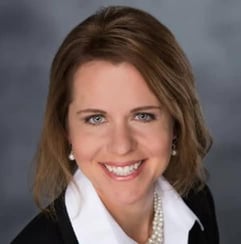
Our experts and industry insiders blog the latest news, studies and current events from inside the credit card industry. Our articles follow strict editorial guidelines.
In a Nutshell: Recent bank failures have highlighted the importance of deposit insurance. The FDIC insures deposits up to $250,000 at FDIC-insured banks. IntraFi provides reciprocal deposit solutions that enable customers to access insurance on deposit balances greater than $250,000. Increased deposit insurance allows community banks to grow and retain more deposits, expanding community lending opportunities.
Safeguarding your company’s payroll, or your nonprofit’s donations or town’s tax revenue, is more important than ever. IntraFi Network’s reciprocal deposit system can get access to additional deposit insurance while also ensuring the money is reinvested locally, creating jobs and fueling the economy.
Luanne Cundiff is the President and CEO of First State Bank of St. Charles, Missouri. For more than 10 years, Cundiff has worked with IntraFi.

First State Bank partners with IntraFi to access reciprocal deposits, which benefit both the bank and its customers. The Federal Deposit Insurance Corporation (FDIC) typically insures deposits up to $250,000. Reciprocal deposits provide protection for deposit accounts with balances greater than the FDIC-insured limit.
“With reciprocal deposits, we can confidently accept large deposits from our customers,” Cundiff said. “If a customer wants the entire deposit amount to have FDIC coverage, and we want to keep that customer’s deposits on our balance sheet, then the deposited money goes into the IntraFi network. We’re then able to take those funds and deploy them in the form of loans given out in our community.”
Cundiff said reciprocal deposits are advantageous for customers who want to have their entire deposit balance insured but don’t want to establish banking relationships with multiple financial institutions.
“Opening numerous bank accounts is cumbersome, and it can also lead to inefficiencies,” Cundiff said. “Reciprocal deposits provide customers with a simple solution to access FDIC insurance for large deposit accounts.”
Aiding Banks In Managing Their Balance Sheets
Customers aren’t the only party to benefit from IntraFi’s reciprocal deposit service. Cundiff said participating banks appreciate the ability to keep a customer’s entire deposit relationship. Reciprocal deposits provide banks with the flexibility to manage their balance sheets in the face of shifting economic conditions.
“Reciprocal deposits create a win-win scenario,” Cundiff said. “A lot of people want to keep their money local so communities can thrive. Reciprocal deposits allow customers to keep their money in a local institution while being fully insured by the FDIC. And it allows us to do what we do best — taking local deposits and loaning that money out to small businesses and consumers in the community. Without local deposits, that can be difficult to do.”

Mark Jacobsen, co-founder and CEO of IntraFi, invented 13 patents related to insured-deposit placement services. “IntraFi’s services help so many different kinds of bank customers including small businesses, public funds, and nonprofits — really anyone who needs to ensure their money is safe,” he said. “Equally important, our products level the playing field among small and large banks. Being able to offer additional access to deposit insurance makes it easier for community banks to compete with banks viewed as too big to fail.”
Cundiff said Jacobsen also realized that depositors’ were interested in having their funds remain at one financial institution without worrying that FDIC insurance wouldn’t entirely cover their deposits.
“That’s how it initially started,” Cundiff said. “Then it just continued growing as more and more banks became interested. Changing the rules around FDIC insurance is very, very difficult. It requires the participation of Congress to facilitate a proposed change. Reciprocal deposits are a way to allow for changes to FDIC insurance while being very transparent in regards to how money is flowing within the IntraFi network.”
Bank Failures Highlight Need for Flexibility
Multiple bank failures occurred during the first six months of 2023. Silicon Valley Bank of Santa Clara, California, was the first bank to fail. The failure of Signature Bank of New York City followed shortly thereafter.
While the announced failure of two banks within a matter of days may have caused depositors to become concerned with the strength of their banking institution, it also caused some banks to reevaluate their processes and product offerings.
Cundiff said the 2023 bank failures motivated many banks to investigate whether IntraFi’s reciprocal deposit program was a solution that could benefit its customers.
When the news of Silicon Valley Bank’s failure began to spread, Cundiff said she gathered First State Bank’s management team to develop a communication plan to address customer concerns.
“I knew that knowledge of IntraFi’s reciprocal deposit program could bring a sense of calm to our customers who were worried about uninsured deposits,” Cundiff said. “It had been years since we’d even fielded a question on FDIC insurance. It was something that consumers and businesses just didn’t feel the need to ask about. But we knew that with bank failures being in the headlines, we were going to be receiving those calls and inquiries.”

Cundiff said that First State Bank’s use of IntraFi’s reciprocal deposit program gave her confidence that the bank would assuage any fears customers may have had.
“We didn’t need to worry — we were ready,” Cundiff explained. “Any customers who were interested in reciprocal deposits could utilize the service. After discussing the Silicon Valley Bank failure and the environment around banking with our management team, we decided to proactively reach out to our customers to let them know of the availability of additional deposit insurance coverage.”
First State Bank posted an open letter to its customers, reassuring them of the bank’s strength and its position in the face of uncertainty within the banking industry. The bank’s relationship with IntraFi featured prominently in the post.
“It’s really all about preparation and being ready for any type of economic situation a bank may face,” Cundiff said.
IntraFi’s Solutions Help Banks Prepare for Uncertainties
IntraFi provides financial institutions with solutions that integrate with a bank’s core processor. Cundiff said First State Bank customers who use reciprocal deposit services can view their entire banking relationships when they access the bank’s mobile or online banking platforms.
IntraFi provides other solutions that can help community banks compete with national banks.
“The reciprocal arrangement is a great way for banks, particularly those that aren’t flush with liquidity, to keep balances within their framework so that they can loan that money out,” Cundiff said. “But IntraFi offers a diversified set of tools that can benefit community banks in any environment they encounter.”
Consumers and businesses that are interested in finding a bank that offers IntraFi’s services can use the company’s Find an Institution tool to search for participating institutions by name or location.
Cundiff said businesses may be more interested in IntraFi’s solutions than consumers.
“Since the failure of Silicon Valley Bank, more and more accounting firms are talking to their business clients about the importance of ensuring all their deposits are FDIC insured,” Cundiff said. “As businesses are getting their taxes done, those conversations are taking place more frequently.”
Cundiff said that customers with high deposit balances may be under the impression that they have to bank with multiple institutions to keep their deposits safe. First State Bank educates its customers so they understand that IntraFi enables large deposit relationships to stay at one bank and be FDIC insured.
“Community banking is still vibrant,” Cundiff said. “And it’s made more vibrant because of the tools we have at our disposal, such as those provided by IntraFi.”


![Does My Credit Card Have Travel Insurance? How to Check ([updated_month_year]) Does My Credit Card Have Travel Insurance? How to Check ([updated_month_year])](https://www.cardrates.com/images/uploads/2015/11/Credit-Card-Travel-Insurance-2.png?width=158&height=120&fit=crop)
![9 Best Credit Cards With Car Rental Insurance ([updated_month_year]) 9 Best Credit Cards With Car Rental Insurance ([updated_month_year])](https://www.cardrates.com/images/uploads/2021/02/Best-Credit-Cards-With-Car-Rental-Insurance.jpg?width=158&height=120&fit=crop)
![5 Best Credit Cards For Paying Car Insurance ([updated_month_year]) 5 Best Credit Cards For Paying Car Insurance ([updated_month_year])](https://www.cardrates.com/images/uploads/2023/07/Best-Credit-Cards-for-Paying-Car-Insurance.jpg?width=158&height=120&fit=crop)
![7 Best Credit Cards With Travel Insurance ([updated_month_year]) 7 Best Credit Cards With Travel Insurance ([updated_month_year])](https://www.cardrates.com/images/uploads/2023/08/Best-Credit-Cards-With-Travel-Insurance.jpg?width=158&height=120&fit=crop)
![7 Cards For Bad Credit With No Deposit ([updated_month_year]) 7 Cards For Bad Credit With No Deposit ([updated_month_year])](https://www.cardrates.com/images/uploads/2021/01/Cards-For-Bad-Credit-With-No-Deposit.jpg?width=158&height=120&fit=crop)
![7 Prepaid Debit Cards With Mobile Deposit ([updated_month_year]) 7 Prepaid Debit Cards With Mobile Deposit ([updated_month_year])](https://www.cardrates.com/images/uploads/2021/08/Prepaid-Debit-Cards-With-Mobile-Check-Deposit.jpg?width=158&height=120&fit=crop)
![7 Easy Approval Credit Cards with No Deposit ([updated_month_year]) 7 Easy Approval Credit Cards with No Deposit ([updated_month_year])](https://www.cardrates.com/images/uploads/2021/11/Easy-Credit-Cards-To-Get-Approved-For-With-No-Deposit.jpg?width=158&height=120&fit=crop)
![$50 Deposit Secured Credit Cards ([updated_month_year]) $50 Deposit Secured Credit Cards ([updated_month_year])](https://www.cardrates.com/images/uploads/2022/09/50-Dollar-Deposit-Secured-Credit-Card.jpg?width=158&height=120&fit=crop)